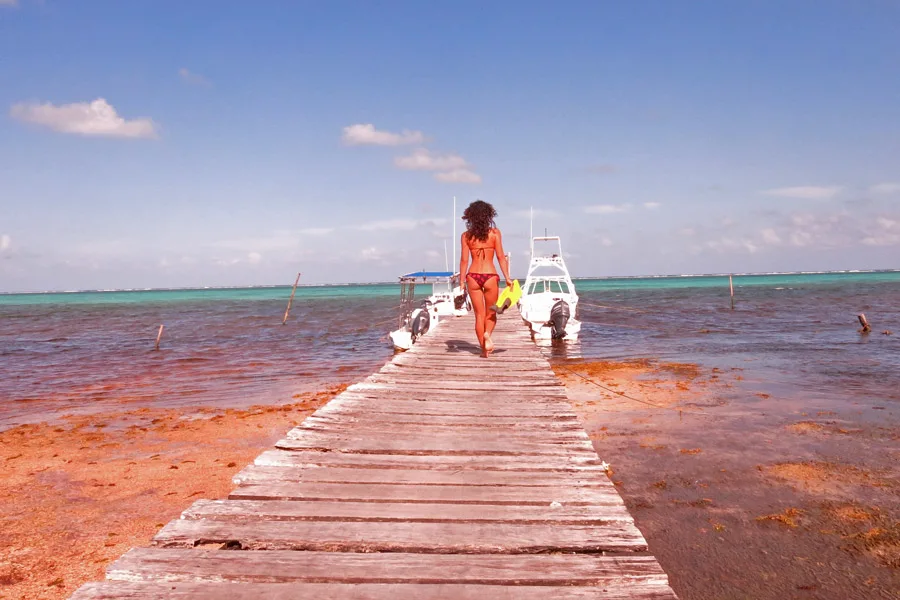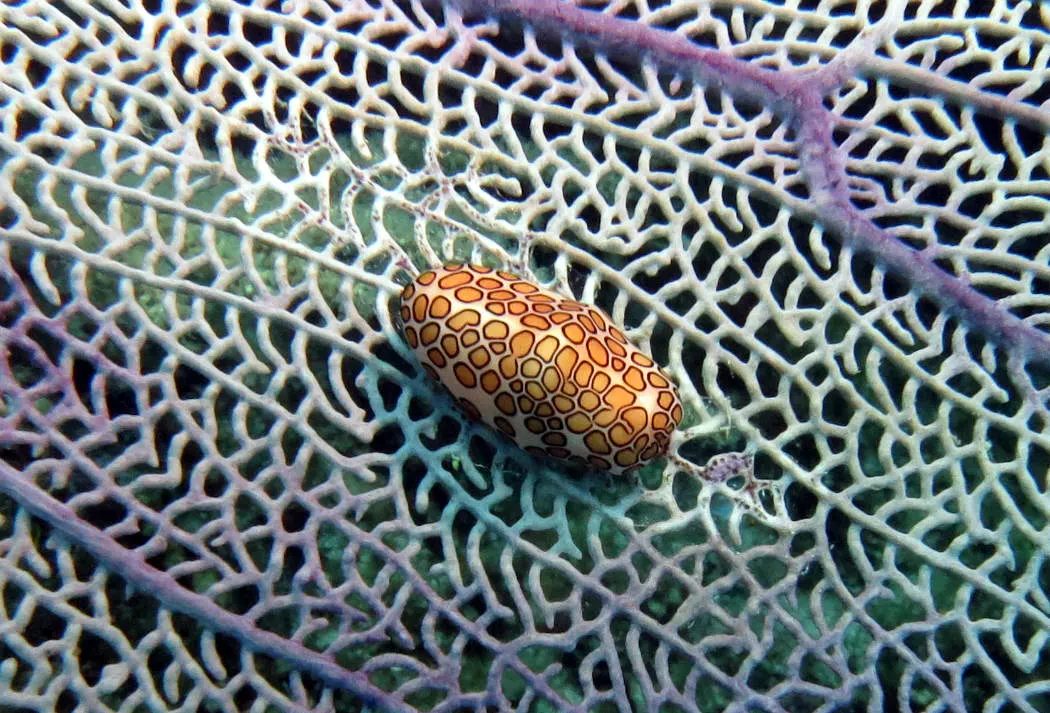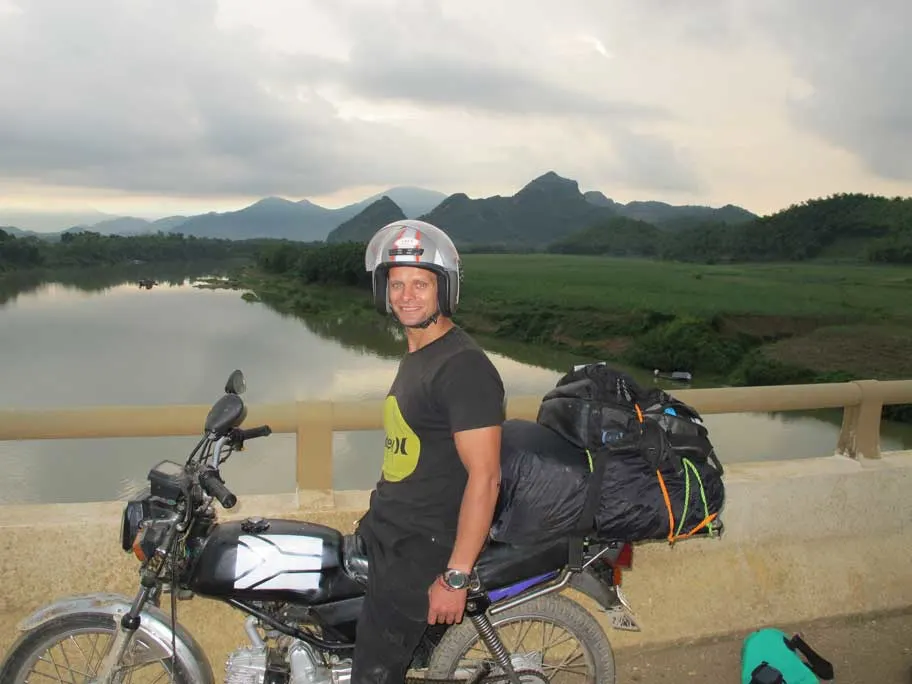Xcalak is a little fishing village located in Mexico right next to the border with Belize. Located on the Meso-American Reef the Xcalak Reef National Park is somehow still one of the best kept scuba diving secrets in Mexico. I have dived and worked as a scuba instructor all over the world and don’t understand how this place is not yet world renowned. Located on the Yucatan Peninsula between the Caribbean Sea and Chetumal Bay the spectacular biodiverse ecosystem surrounding Xcalak includes wetlands, lagoons, mangroves, rivers, and amazing coral reefs. Scuba diving on the healthy coral reefs of Xcalak, divers have plenty of swim throughs, walls and caverns to navigate, often seeing dolphins, sharks, rays and a variety of hunting pelagic species.
Our favorite spot to dive in Mexico and the best diving I did in the Caribbean. Xcalak can not compare with the explosion of life and colour you encounter when diving the best of South East Asia, but three incredible highlights of diving from Xcalak are; the huge resident school of large tarpon, the big population of manatees often encountered on dives and the saltwater crocodiles you can skin dive with in Banco Chinchorro. In my opinion if you can see one of these it is already worth the trip and all three are possible.
Another off the beaten track spot we really enjoyed in the Caribbean was Little Corn Island, a real Caribbean vibe and nice diving and snorkeling.
Diving from Xcalak is not cheap, a 3 tank dive day costs $165 and going to Banco Chinchorro $185. Gear rental is an additional $25.
Another dive not to miss in Mexico is the spectacular cenotes, check out our Cenote Dive Guide, the underwater caves of the Yucatan peninsula is truly something special
Xcalak Mexico – the Little Fishing Village
Located in the Costa Maya, the southern part of Quintana Roo on the Caribbean coast of Mexico, Xcalak is only about 20 km (7 miles) from Belize. This rustic village, with only 375 permanent residents has hardly been touched by tourism and is home to world class fly fishing and bird watching. The sleepy little rural town of Xcalak is not the most beautiful town with little activity and some rubbish washed out on less than perfect beaches. Far away from resorts, touristy beaches and international franchises Xcalak is however surrounded by unreal natural treasures and visited by more adventurers and explorers than average tourists. The town is the departing point for excursions to the elusive Banco Chinchorro coral atoll. This legendary dive spot, visited by few is home to spectacular coral reefs, tiny islands, more than 200 shipwrecks and is probably the best spot in the world to dive with salt water crocodiles.

Xcalak is not a beach tourists dream, but is a great Carribean town to explore, drink rum, eat cerveza and organize diving and fishing activities most only dream of.
Scuba Diving in Xcalak
Traveling for diving is usually not cheap and going to remote locations can be difficult and complex. Excursions to these off the beaten track locations, must really offer something special to make it worth the time and the effort. Xcalak is one of a handful of spots in the Caribbean I felt was worth the time and money we spent to get there specifically for diving.
Located on the Great Maya reef, Xcalak offers a variety of incredible dive sites, steep walls, canyons, swim throughs and unique geographical formations to explore inhabited by a massive variety of marine creatures. Diving in Xcalak expect to see turtles, rays, sharks, dolphins and a large variety of fish swimming over the beautiful reef with hard and soft corals, large fans and some beautiful and interesting nudibranches.
The reefs closer to shore and lagoons have a large population of resident manatees that are often seen on the dive sites. The most famous inhabitants of the reefs surrounding Xcalak is the massive school of large tarpons.
From Xcalak go to the famous Banco Chinchorro atol with some of the most pristine reefs and spectacular diving anywhere in the northern hemisphere. This is also the place to dive with Saltwater crocodiles.

Dive training at Xcalak
With awesome facilities and a huge variety of dive sites this is a great place to do dive training. XTC dive center is a 5 star IDC PADI center that offers the full range of courses from a one day Discover Scuba Diving to instructor courses. Many people stay here for a couple days to do their Openwater and advanced training. I will recommend you read a couple of tripadvisor reviews before making a booking.
This is also a very popular place for technical dive training offering the complete range of courses Sidemount, Tec and Rebreather.
Want to do your dive training in South East Asia? Koh Tao is a great spot, this beautiful little island is filled with awesome dive schools doing every type of training, check out our article on best dive schools in Koh Tao.
Xcalak Dive Sites
La Poza
Max Depth: 22m Avg Depth: 11m Temp: 25C Viz: 20m
La Poza is the most famous dive site in Xcalak known for encounters with schools of tarpon, manatees are also often seen here. The site is located close to shore, a quick boat ride from the jetty. It is a fairly shallow dive suitable for all levels. It is common to see snappers, barracuda, trevally, groupers and eagle rays diving on this site. The tarpon swim through gaps in the reef to find some shelter from strong currents. It is an amazing big fish diving experience swimming these incredible prehistoric looking fish. There are hundreds of fish in the big schools and some of these giant fish are about 2m (7ft) long and I estimate over a 100kg (200 pounds+). Definitely the site not to miss diving from Xcalak.

Cañones
Max Depth: 30m Avg Depth: 17m Temp: 25C Viz: 20m
Nice dive site located close to Xcalak. Fantastic views over the coral spurs. Some interesting nudibranches on the reef. Many invasive lionfish on this reef, our divemaster caught them with a hawain sling speargun for the restaurant, you can order the lionfish at the restaurant it is delicious! We had a school of dolphins come by on the safety stop.
La Chiminea
Descend next to a drop off from 13 m to about 35 m sloping sand bottom goes deeper. Nice coral garden with plenty of parrot fish. Swim to “La Catedral ” at about 28m, a large cavern with a big collapsed rock in the center. Turtles, moray eels, big groupers, tarpon, barracuda, and schools of silver sides are often seen here. Swim up a canyon to a long swim through, ascent through The Chimney.
Advanced divers only. Max Depth 35m

La Pozeta
Dive site drops from 5m to about 30m, lots of very nice swim throughs and beautiful coral reefs. Manatees are often seen at this site.
Diving Banco Chinchorro
Banco Chinchorro is a UNESCO Biosphere Reserve and the largest coral atol in the Northern Hemisphere. It is famous for excellent diving hosting pristine coral reefs, huge barrel sponges, plenty of wrecks and amazing marine life. The coral atol is located about 30 km (18 miles) from Xcalak and it takes roughly an hour to get here by boat depending on weather and the boat you are going with. It is a long drive and a government permit is required so diving here is not cheap.
Expect to see unspoiled reefs teeming with life. Marine animals often seen diving in the clear warm water of Chinchorro include large groupers, napoleon wrasse, lobsters, barracudas, crabs, green turtles, stingrays and reef sharks. Stop at one of the simple fishing houses on stilts and check out the big iguanas and thousands of hermit crabs on the tiny island, with a bit of luck you can spot a crocodile or two during lunch.

Snorkeling at Banco Chinchorro
Banco Chinchorro is renowned for great snorkeling on the wonderful reefs with plenty of fish, reef sharks and other marine life easily reached by snorkel. Some of the wrecks are very shallow and great to explore snorkeling Check out the wreck site of a wooden ship called 40 Cannons for some of the best snorkeling in the area.
Crocodiles at Banco Chinchorro
Snorkeling with the American Crocodile (Crocodylus Acutus) is an exciting, unique activity you can do at Banco Chinchorro. These animals can grow very large, up to 6m long and weigh 900kg.
To interact with the crocodiles, the XTC dive center in Xcalak combines diving the Banco Chinchorro with an American Crocodile encounter. You will stay on the atol for 3 days and two nights, dive some of the wrecks and reefs around the atol and spend 3 to 4 hours per day in shallow water (1 – 1.5 m/3-5 ft.) around a fisherman’s hut skin diving with the crocs.
Croc expeditions run from June 1st through to September 30th (weather dependent).
The American Crocodile mainly inhabits salt and brackish water such as rivers, lagoons and swamps, it has a high tolerance to salinity, similar to the saltwater crocodile. This crocodile species is not seen as very aggressive for a crocodile species and does not often attack humans. We are not part of their diet, but American crocodiles have reportedly been responsible for 36 attacks on humans from 1995 to 2017 in the Cancun area of Mexico.
Planning a dive trip? Don’t Miss our Dive Travel Packing List
Snorkeling from Xcalak
Xcalak offers some great snorkeling. Snorkeling from the jetty where dive boats launch in the village, it is quite shallow sandy bottom with small patches of reef, but we saw a couple of eagle rays, a barracuda, a turtle and some other fish. For the best snorkeling trips are offered by XTC dive center and you can go on either 2 or 5 hour excursions to the coral reefs, where you can see a large variety of fish, sometimes even the large tarpon. The boat stops at spots on the reef that are shallow enough for comfortable snorkeling in the clear, warm water. On snorkeling trips to Xcalak Reef Marine Reserve, Manatee reserve and the mangrove forest manatees are often seen. Following a snorkeling excursion the boat often stops for some bird watching

Mexico is one of the best places in the world to swim with Whale Sharks, the peak season in the Yucatan for this awesome adventure is July and August. We did some fantastic snorkeling with whale sharks in the Philippines, see our guide to different whale sharks swimming spots in the Philippines and our take on the controversial feeding of whale sharks of Oslob in Cebu.
More Things to do in Xcalak
Fly Fishing – This iconic fly fishing spot hosts large residential schools of bonefish, permit, tarpon, jacks, cudas and more.
Fishing trips – Chetumal Bay, only a 15 minute boat ride from Xcalak, offers some of the best permit fishing in the Carribean.
Bird watching – Xcalak is a hidden gem for Carribean bird watching with pelicans, egrets, frigate birds, grackles, interesting local birds like the Ocellated Turkey and more often being seen here.
Bird Island excursions – go on an excursion in the Bay of Chetumal driving through the canals by boat, stop to do some snorkeling. Great bird watching and maybe run into the resident manatees living in the mangroves.
Kayaking or Stand Up Paddleboard (SUP) – rent a kayak and explore the bay or go on a guided kayak or SUP trip in the mangroves and the lagoon see birds, fish and maybe even crocs or manatees!
Cycle – Rent a bicycle and explore the little Carribean town.
Getting to Xcalak
This off the beaten path destination is not easy to get to. Xcalak is about 400 miles / 650 kilometers from Cancun, a five to six hour drive or a long day or two on public transport. The easiest way is to rent a car. Driving from Cancun Airport it is about a 5 hour drive. Look at Rental Car for a comparison of rental cars from a variety of agencies at the best prices.
To get to Xcalak by public transport you must first get to Chetumal, the city has an airport or you can arrive by Ado Bus from Cancun, Playa del Carman, or Tulum, this can take all day.
There are two daily Caribe buses from Chetumal main station to Xcalak taking about 4 hours to arrive in Xcalak. `The Caribe bus will drop you off at the Xcalak town pier
Accommodation in Xcalak
Xcalak is a small place, so there are not many accommodation options.
Costa De Cocos Nice bunglows on the beach, excellent location, great reviews, check it out.
There are some private apartments for rent in Xcalak, see on AirBnB or ask at the dive operator you are using.
Dive Insurance
Xcalak is a remote location, Scuba diving does have risks, make sure your health and your gear is covered, read the small print. World Nomads Diving Insurance

The strong half of Stingy Nomads, a nomadic aquaman that would be happy to spend all his life in the water diving, surfing and spearfishing but often has to compromise with Alya and go hiking instead. Campbell is responsible for all our marine adventures and following them with write-ups. He loves traveling, braai (BBQ in South Africa), red wine and spending the day in a wetsuit.

Mireia
Tuesday 15th of June 2021
Can you snorkel with whale sharks in Xcalak?
Stingy Nomads
Wednesday 16th of June 2021
Hello Mireia, as far as I know whale sharks can not be seen from Xcalak. There are Xcalak trips online includng crocodiles, tarpons, manatees and whale sharks. Most of these trips went diving with whale sharks from another destination like Cancun.
Kim Rogers
Sunday 31st of January 2021
I am a dive pro in Cozumel. The pic of a "nudibranch" is not a nudibranch at all It is a Flamingo Tongue Snail.
Stingy Nomads
Thursday 4th of February 2021
Hello Kim, thank you for pointing that out!
Heather S
Monday 8th of January 2018
Hi guys, good post about Xcalak diving! I've dove there as well, and I agree that it is expensive to dive with XTC. They're really professional like you mention, but wow. If you're used to rates in Asia it's a bit of a rude wakeup call.
The tarpons are what I enjoyed most too! The crevasses were really interesting, and the sites were really fast to get to which was a bonus. I think though, that I agree with you - not so much a colour explosion as Asia can be. I actually recommend snorkeling in Xcalak before diving, unless you're pretty hardcore.
One thing about XTC - if you train as a Divemaster there, you get free diving with them for life! Not that you'd necessarily be in the neighbourhood that often...
In case your readers want to know more about visiting Xcalak, my husband and I made a guide XcalakMexico I think you will agree that the online information about Xcalak can be pretty crap. Well, we decided to change that so we have a free guide that has stuff about transportation, accommodations, things to do, etc.
Thanks again for your post about Xcalak diving, I found it both fair and honest.
inge
Friday 4th of February 2022
@Heather S, Hi heather, We (my 2 adult kids and me)are trying to inform us about Xcalak diving in comparance to Cozumel diving. WE never have been diving in this regio before. I am experienced, my 2 kids not so experienced yet. Would it be possible for you to inform me about this guide that you and your husband wrote, if that would help to make a decision where to go? Is Xcalak reef much more expensive than Cozumel? Thank you so much for your help! Wishing you a splendid day, Inge